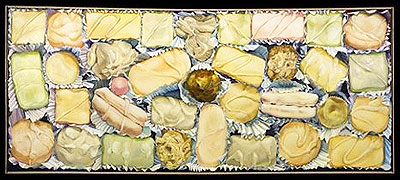“Seductive Subversion: Women In Pop Art”
Published on March 30th, 2011 in: Art, Back Off Man I'm A Feminist, Current Faves, Feminism, Issues |By Chelsea Spear
Exhibit at The Aidekman Center for the Arts
Medford, MA
Free association: When I say the words “Pop Art,” what comes to mind? Screen-prints of Brillo boxes and Campbell’s soup cans, Ben-Day dots on comic-strip women, cartoon collages. And pop artists? Andy Warhol, Roy Lichtenstein, Richard Hamilton, maybe Jasper Johns and Robert Rauschenberg. Like most art movements, Pop Art is considered to be a boys’ club. “Seductive Subversion” seeks to turn this misconception on its head.

Kay Kurt
For All Their Innocent Airs, they Know Exactly Where They’re Going, 1968
Like many exhibits featuring work from an under-represented population of artists, “Seductive Subversion” can fall into an essentialist view of women in art. The first room at the Aidekman Center focuses on sexually explicit art by women of this era. The first painting that caught my eye was For All Their Innocent Airs, they Know Exactly Where They’re Going, Kay Kurt’s wall-sized canvas of what appears to be a box of candy. On closer inspection, the pastel-colored treats looked less like Russell Stovers, and more like . . . the female stuff of life. Across from that was positioned Marjorie Stryder’s Green Triptych, which depicted a trio of beach bunnies, rendered anatomically correct in bas-relief detail. This playful three-way looked like something you might find in a man-cave or a basement bar of the era, taken to its logical extreme. In other areas of the gallery—as in a wood sculpture of John Wayne that dominates the second room—the artists explore issues of sexuality in an open, yet whimsical, way.
The curators of “Seductive Subversion” have incorporated art forms that one doesn’t normally find in these kinds of gallery shows. Of particular interest to a fiber fan such as myself were Dorothy Grebenak’s latch-hook rugs of logos of masculine brands such as Bugati motorcycles, or of manly icons like Babe Ruth. The lower level of the gallery featured several soft-body dolls, some of which were handmade by Jann Haworth, co-creator of the Beatles’ iconic Sgt. Pepper’s Lonely Hearts Club Band.
Though invested with an inclusive sensibility and an interest in deconstructing its audience’s preconceptions about Pop Art, “Seductive Subversion” also features work that one would regard as “traditional” Pop. Martha Rosler’s photomontages would be right at home alongside Richard Hamilton’s better-known work. Likewise, the mural Munchkins by Idelle Weber reduces the morning commute to a series of elegant metallic silhouettes and foreshadowed both the opening credits for the TV series Mad Men and the sleeve art for many ZE Records releases, while Rosalyn Drexler’s reinvented cinema imagery reduces the essence of home movies and Jimmy Cagney double-features to a series of black-and-white poses against lurid day-glo backgrounds, drawing the eye in with the heightened color and scale contrast.

Idelle Weber
Munchkins I, II, & III, circa 1964
In an exhibit about Pop Art, the ironic distance—and yes, subversion—might seem at odds with art that could be described as “poignant” or—to be even more daggy—”inspirational.” However, the canvases of Faith Ringgold definitely hit those sweet spots. The narrative staging of her paintings suggested Norman Rockwell, while the folk art-influenced execution and washed-out colors seemed to point the way for Lynda Barry’s stories of Marlys and Maybonne. In a video interview, Ringgold spoke of the need to keep pursuing art, even if the world tells you that you shouldn’t—a good moral of sorts for many of the setbacks female artists faced in the 1950s and ’60s.
The exhibit seemed to leave out at least one artist whose work was tremendously influential: Whither Sister Corita Kent, whose screen prints were as ubiquitous as Warhol’s in their day? In spite of this oversight, “Seductive Subversion” expands the view of Pop Art to examine the effects of media on women, and how women engaged it.
For more on this exhibit, please visit the Tufts University Art Gallery website.
Time limit is exhausted. Please reload the CAPTCHA.